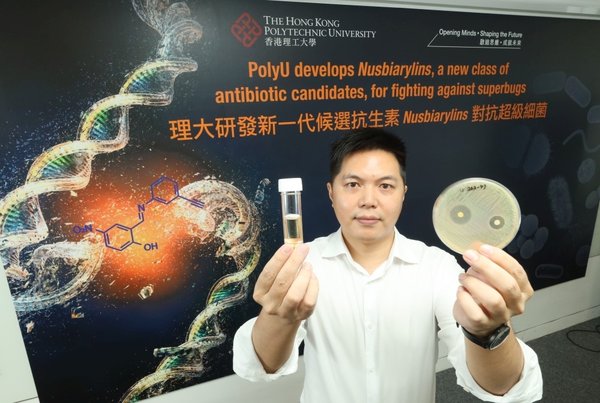PolyU develops a new class of antibiotic candidates for fighting against superbugs
HONG KONG,Sept. 24,2019 -- The Hong Kong Polytechnic University (PolyU) has developed a new class of antibiotic drug candidates which has high potential to be developed into a new generation of antibiotics fighting against multi-drug resistant superbugs including methicillin-resistant Staphylococcus aureus (MRSA). The novel small molecules,based onnew target,new chemical structure and new antimicrobial mechanism,are different from those of existing antibiotics. The new drug candidates demonstrate much effective abilities of inhibiting bacterial growth than commonly used antibiotics,yet with no toxicity to human cells.

The research team of the State Key Laboratory of Chemical Biology and Drug Discovery of PolyU’s Department of Applied Biology and Chemical Technology (ABCT) develops “Nusbiarylins”,a new class of antibiotic candidates for fighting against superbugs. The research team is led by Dr MA Cong.
Drug resistance has been declared as one of the biggest threats to global health in 2019 by the World Health Organization,with MRSA becoming one of the most serious concerns.[1] Hong Kong cannot be spared from the worsening scourge of MRSA. In 2018,there were 1,218 reported cases of community-associated MRSA (CA-MRSA),or a seven-fold of the figure in 2007-- the year the disease became notifiable in Hong Kong.[2] As of August this year,there were already 839 cases reported. Despite of tremendous pharmaceutical research and development investments worldwide,the search for new antibiotics has showed no progress since mid-1980s.
The development of "Nusbiarylins",a new class of antimicrobial agents,by the research team of the State Key Laboratory of Chemical Biology and Drug Discovery of PolyU's Department of Applied Biology and Chemical Technology (ABCT),is thus a breakthrough in the battle against multi-drug resistant bacterial infections. The interdisciplinary team,led by Dr MA Cong,Assistant Professor in ABCT,comprises of experts from both PolyU and Faculty of Medicine of The Chinese University of Hong Kong.
"Our research is now in the stage of animal studies,conducting infectious model studies and pharmacokinetic studies. These are the critical steps preceding clinical trials on human for drug development. At this moment,there are very few antibiotic related studies being able to complete such stage worldwide. Our findings so far are very promising. We believe further studies on these compounds will contribute to a new era of antibiotic discovery,contributing towards the fight against superbugs," said Dr Ma.
[1]Ten threats to global health in 2019,World Health Organization https://www.who.int/emergencies/ten-threats-to-global-health-in-2019 (accessed 23 September 2019)
[2]Number of notifiable infectious diseases by month,Centre for Health Protection,Department of Health,The Government of the HKSAR
https://www.chp.gov.hk/en/static/24012.html (accessed 23 September 2019)
New target being identified by innovative antimicrobial mechanism
Most antibiotics currently in the market fight against bacteria through disrupting its DNA synthesis or protein functions. The innovative antimicrobial mechanism developed by PolyU team focuses on inhibiting the interaction between two proteins,NusB and NusE,which is crucial for synthesis of bacterial ribosomal RNA (rRNA). By designing small molecules to disrupt NusB-NusE interaction,bacterial cell proliferation can thus be curbed.
The team developed a model basing on the structure of NusB and NusE,and applied computer-aided screening to screen about 5,000 small molecule compounds with drug-like properties to explore for inhibitors for NusB-NusE interaction. The shortlisted compounds were then put to tests for antimicrobial activity against different MRSA strains. A compound,(E)-2-{[(3-ethynylphenyl)imino]methyl}-4-nitrophenol (hereafter addressed as MC4),was identified as having much effective antibacterial abilities than the commonly used antibiotics. The Minimum Inhibitory Concentration (note: MIC denotes the lowest concentration of a chemical/drug for preventing bacterial growth) of MC4 for some MRSA strains are as low as 8 μg/mL,compared to the MICs of >64 μg/mL demonstrated by two antibiotics in the market,oxacillin and gentamicin.
Test of MC4 on human lung and skin cells (infections caused by MRSA often occur in these tissues) indicated no significant toxicity. The fact that NusB and NusE exist only in bacteria and not human cells has also addressed toxicity concern.
"Nusbiarylins"- a new class of antibiotic candidates
The research team has further structurally modified MC4 for optimization,and 167 analogues were synthesized so far. The new class of compounds are named as "Nusbiarylins" (basing on their target protein "NusB" and their "biaryl" structure). Laboratory test of Nusbiarylins against a panel of MRSA strains proved their consistent antibacterial activity,some with MIC as low as 0.125 μg/mL,much better than commonly used antibiotics,including vancomycin with the MIC of 1 μg/mL which is labelled as the "last resort" antibiotic drug in the United States.
Further pre-clinical studies on the in vitro pharmacological properties of Nusbiarylins on human cells indicated that the compounds:
leading to nearly no hemolysis (i.e. human blood cell breaking),an indication of being safe for injection; and
with excellent result in intestine absorption,implying being effective for oral taking.
The findings have been recently published in leading scientific journals (listed below). The innovation has also won the "Global Innovation Award" at the TechConnect World Innovation Conference and Expo 2019 held in June in the United States.
Recently published journal papers:-
Xiao Yang,Ming Jing Luo,Apple C M Yeung,Peter J Lewis,Paul Kay-sheung Chan,Margaret Ip,Cong Ma. First-In-Class Inhibitor of Ribosomal RNA Synthesis with Antimicrobial Activity against Staphylococcus aureus. Biochemistry 2017,56,5049-5052.
Tsz Fung Tsang,Yangyi Qiu,Lin Lin,Jiqing Ye,Cong Ma,Xiao Yang. Simple Method for Studying in Vitro Protein–Protein Interactions Based on Protein Complementation and Its Application in Drug Screening Targeting Bacterial Transcription. ACS Infectious Diseases 2019,5,521-527.
Yangyi Qiu,Shu Ting Chan,Tsun Lam Shek,Tsz Fung Tsang,Nilakshi Barua,Yufeng Zhang,Nicolas Blanchard,Gilles Hanquet,Zhong Zuo,Xiao Yang,Cong Ma. Design,Synthesis and Biological Evaluation of Antimicrobial Diarylimine and Amine Compounds Targeting the Interaction between the Bacterial NusB and NusE Proteins. European Journal of Medicinal Chemistry 2019,178,214-231.
Yangyi Qiu,Cong Ma. Nusbiarylins,a New Class of Antimicrobial Agents: Rational Design of Bacterial Transcription Inhibitors Targeting the Interaction between the NusB and NusE Proteins. Bio-organic Chemistry 2019,92,103203.
Photo - /20190924/2590159-1?lang=0